I am often asked how to incorporate more veggies into the diet. This article courtesy of Vogue highlights a great way to do that and your kids will also love it!
Like fashion, no food trend is ever truly new—just reinvented. Take spiralized vegetables, for instance—the pasta-like ribbons of produce that have recently taken over our Instagram feeds and launched a generation of blogs and book deals—which are being credited with everything from weight loss to curing spaghetti cravings. This latest health food of choice was not invented in our carbphobic era (though it certainly seems made for it). Once commonplace garnishes in restaurants in the eighties and nineties, now these vegetable strips have become the main course, with cookbook authors on both side of the Atlantic, including the beloved Hemsley sisters, writing them into their cultish recipes and even endorsing spiralizers the machines responsible for uniformly slicing zucchini and cucumber into thin bands.
But is turning butternut squash into fettuccine a realistic alternative for those who crave pasta but are carb-averse? “We eat with our eyes,” points out New York City–based nutritionist Tanya Zuckerbrot MS, RD, “and it absolutely looks like pasta.” Zuckerbrot makes a good argument, especially considering that, from a caloric and carbohydrate perspective, the swap is an inarguable health upgrade. Compare two cups of pasta weighing in at 480 calories, 90 grams of carbs, and two grams of fiber with two cups of zucchini zoodles at 66 calories, twelve grams of carbs, and four grams of fiber. Seems like a no-brainer, right?
It is if you’re using the right ingredients and the right sauce. “Not all vegetables are created equal,” says Zuckerbrot. “Zucchini and carrots are different from potatoes [which are] significantly higher from a caloric and carb perspective.” Meanwhile beets, summer squash, and jicama are as low in sugar as they are high in vitamins. And as healthy as a cup of zucchini noodles are by themselves, tossing them with a sauce that trades high-fat cheese for omega-rich avocado will only increase the benefits.
Now that companies like Hungryroot are capitalizing on the spiralizing craze—swooping in to take the guesswork out of the kitchen by delivering packaged meals of precut vegetables, along with health-conscious homemade sauces and roasted vegan toppings (additional animal proteins are optional) for you to prepare at your convenience (in less than seven minutes)—taking part in the trend has never been easier. Because, regardless of the waist-whittling effects of ordering vegetable noodles or slicing your own, replacing pasta with spiralized carrots or turnips is an infallible route to increasing your daily intake of vegetables, and with them, skin-brightening vitamins and minerals. How is that for holistic health?











